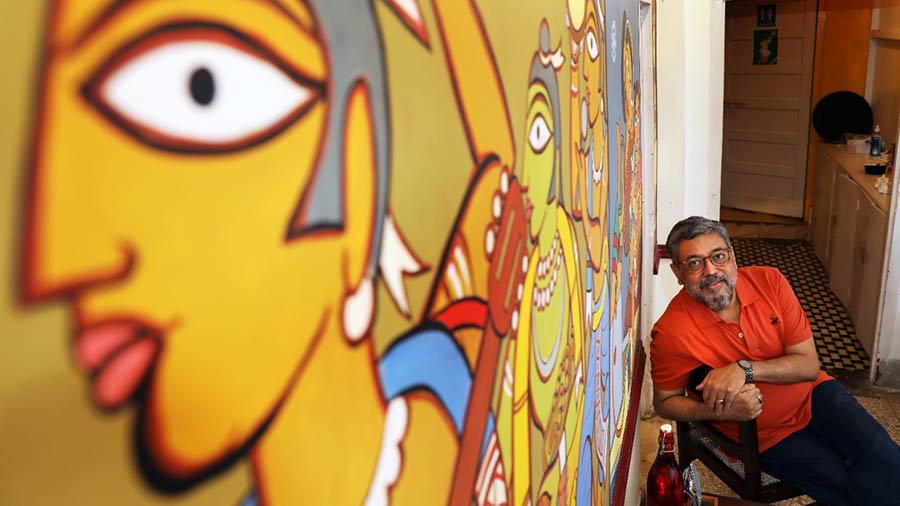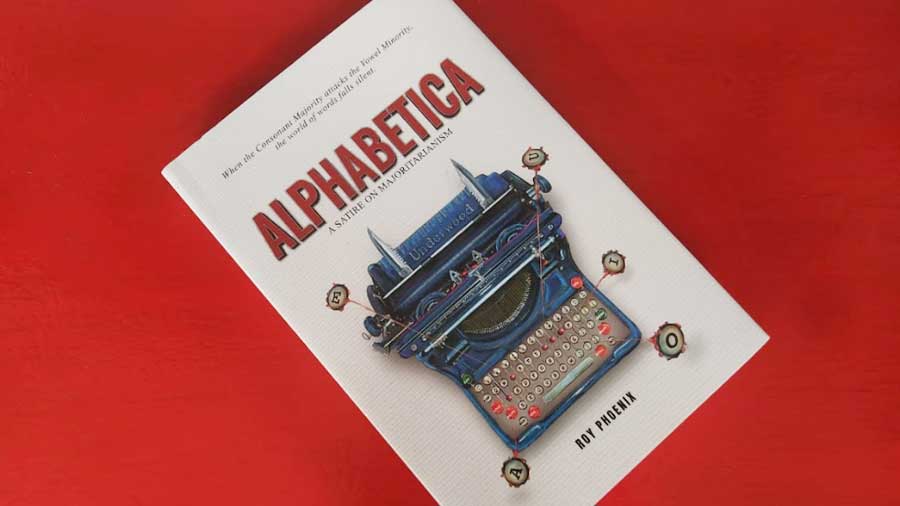Visitors to Café Kolkata 32 at Bijoygarh are welcomed by a cat grabbing a cellphone in its mouth, a mother carrying a child in its lap while working on a laptop and a band of traditional musicians with modern instruments.
The hand-drawn paintings on the walls of the cafe are a contemporary tribute to artist Jamini Roy to mark his 50th death anniversary. The artist behind the Jamini Roy-inspired paintings is ad man and author Kaushik Roy.
My Kolkata met up with Roy at the cafe to chat about his thought behind the wall art, his association with art and more
The cafe walls
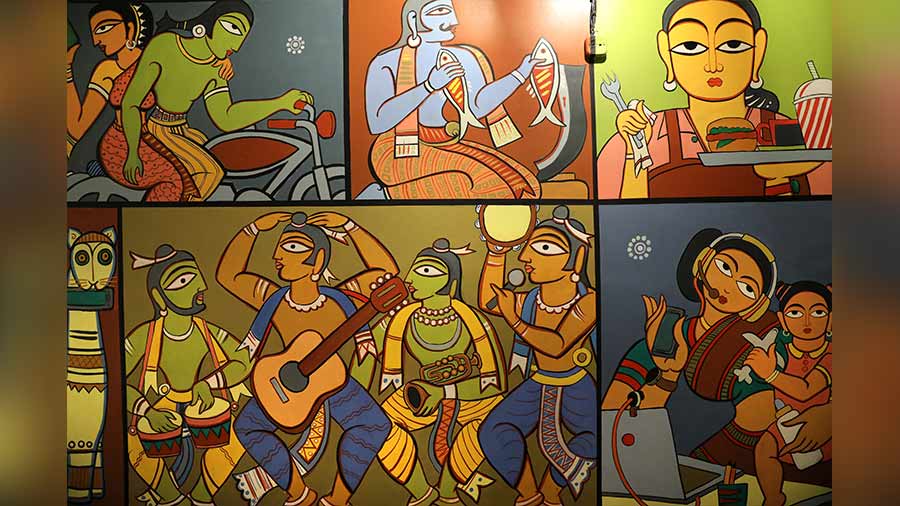
A wall of the cafe
The walls of Café Kolkata 32 have got a whole new makeover with brush strokes.
“Rangan (Chakravarty), the owner of the cafe, is an old friend and he had long been telling me to come and paint a wall of the cafe. He wanted something that would be appreciated by the people of Kolkata,” Roy said. “Youngsters of my time were all very fascinated by Jamini Roy. While sketching a few of his paintings, it struck me that they all had something about the people of his time. I started with the mother-son duo and said to myself what if this is the work-from-home mother? I made a few drafts not knowing that I would be painting this wall. But I merged the two and the rest of the sections in keeping with the ethos of the café.”
Bur Roy was also careful not to distort Jamini Roy’s works. “When I was doing this, I had it at the back of my mind that I should not distort the original work. The art of Jamini Roy is very easy to copy and distort by adding elements to it. I have tried to be as respectful of his paintings through my work. Very often when art is simplistic it looks easy. But I rediscovered Jamini Roy through the process,” said the South Point School alumnus.
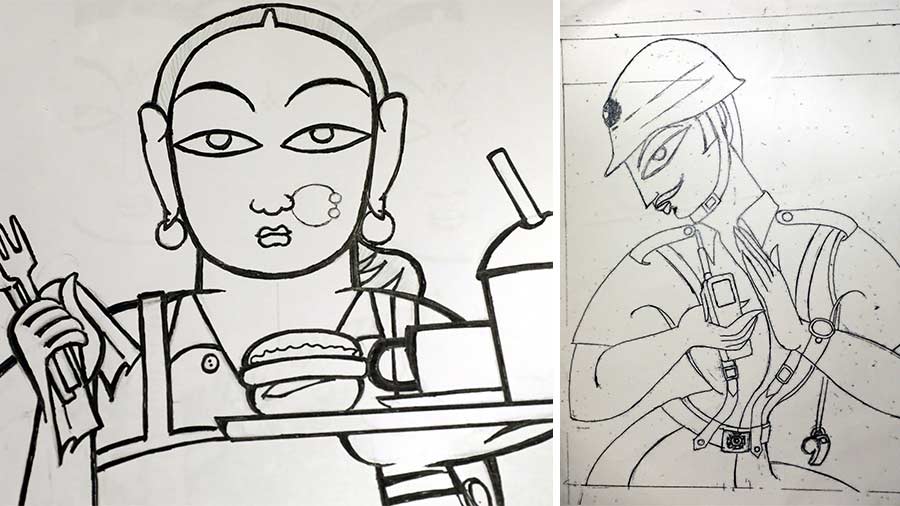
Some sketches by Kaushik Roy
Roy chose acrylic as his medium. “Acrylic dries quickly and I can apply the second coat of colour to make an opaque look. Most Jamini Roy paintings are in solid shades, so no part can be left with a lighter shade. It also gives you the option of putting a lighter colour on a darker colour, once dried,” he said.
Roy was helped by local artists Subrata Kar and Sourav Jana who worked with him to give the wall its final look. “We thought that we could finish it in three days. But it took longer because of the detailing in every image. We started on August 7 and continued till August 16. On August 19, we returned to the cafe to apply the lacquer for colour protection. I was assisted by two young artists. It needs patience and skill to colour at heights. So, they were big assets during the process,” he said.
Artistic cafe

Kaushik Roy has given Jamini Roy’s paintings a modern twist, while ensuring that the original art is not distorted
For Chakravarty, the wall art was not a very conscious thought process. “We wanted to make the interiors interesting. Nowadays, there is a trend for ‘selfie- friendly cafés’ on Instagram. Most people who come here — children, women, young girls, older people — click a lot of selfies. So, I thought if selfies are what people want, then it’s better to cultivate different artistic tastes in people. We keep books in the café for people to browse and read. There is a magnetic wall with old film posters and book covers, too. We are trying to make the café interesting in a Bangali way!”
The artist
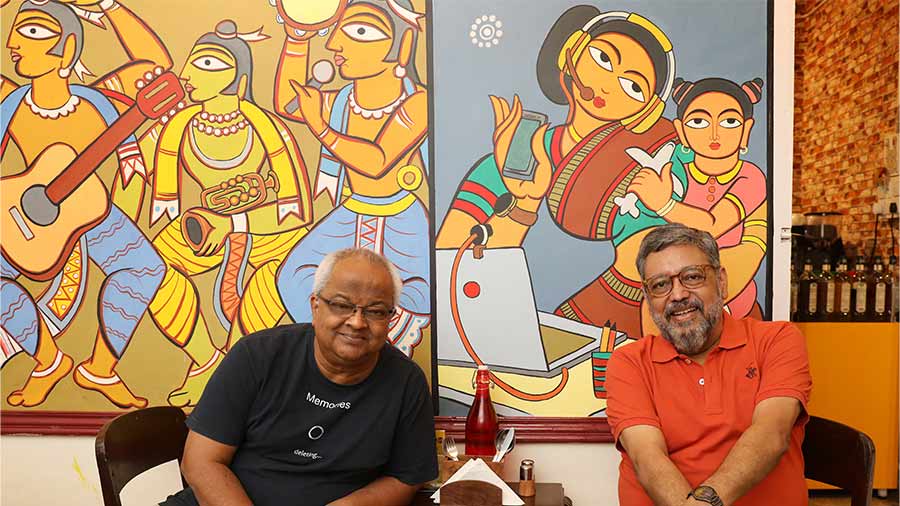
Rangan Chakravarty and Kaushik Roy at the cafe
Roy had always had an interest in art. The walls of his ‘den’ at home were filled with doodles and graffiti but he never formally trained in art.
But corporate rush and professional rush made Roy almost give up painting. While pursuing his graduation in Political Science from St. Xavier’s College, Kolkata, Roy started working with an advertising firm in the late 1970s. “I was initially in the creative department but then I got into client servicing. Then my track changed and I got into the managerial side of business,” he said. “Even though I switched disciplines, I tried to stay close to the creative process everywhere.”
Roy picked up the brush once again sometime in the 2000s. “It was a kind of stressbuster for me. My younger son is on the autism spectrum. When he saw me paint, he got interested in painting. We inspired each other. We even had two exhibitions together. Much of whatever I have done is because of him. I’m not a professional artist. In 2020, I decided to retire from my full-time job and have more time to myself. That is when I started writing and painting,” said the author of Alphabetica.
His years in creative advertisement did help Roy gain focus in art. “In advertising or creative communication we don’t always look at the principles of fine art but are influenced by a lot of work happening around us. Creating the mural at the cafe involved a visualisation process, which is an important element of advertising.”
Enjoying art
For Roy, the canvas is like a playground “where you can start somewhere and end somewhere completely different”. “That inspires me and makes my work very organic,” he said.
“I would use a lot of oil paints earlier but then I stopped. The problem with oil is if you try to speed up the process, the canvas cracks. But acrylic gives me the flexibility and the speed. I also use oil pastels on canvas,” Roy said.

Another view of artwork on the café's wall
The most artistic city
“Undoubtedly Kolkata”, said the artist who has been inspired by Jamini Roy and Gopal Ghosh. “I think Kolkata is a very artistic place. Art is appreciated and you will find a lot of young struggling artists who may have had to face a lot of resistance where they would have been told ‘chhobi enke kichhu laabh nei’. But they still continue to paint. Even in our childhood there used to be a drawing school in the neighborhood where all the kids used to sit on the floor and draw.”
“Maharashtrians are very good artists. But the whole city is so commercially driven that whatever little art is meant to be there is overshadowed. Everything is very glitzy and plastic-y. But there is one thing about Mumbai, the speed and the energy of the city is like no other,” said Roy, who is currently working and researching on his second book, which is a fictional biography.
